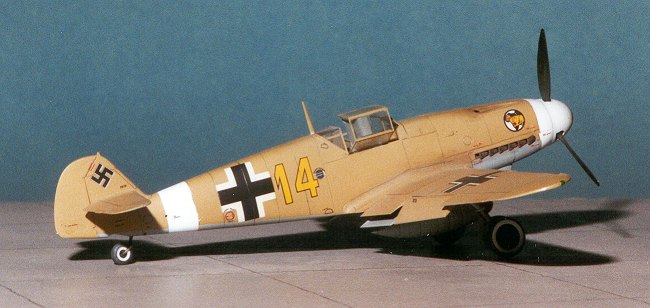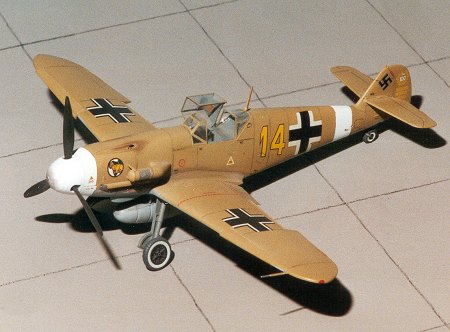
Kit: Bf-109F-4/trop
Scale: 1/48
Kit Number: J13
Manufacturer: Hasegawa
Price: $23.98
Media: Injected Plastic
Decals : Several versions, all desert scheme.
Date of Review: 1 June 1996

Comments: Greetings from the Messerschmitt man. I build a lot of these aircraft, and this one is an F version from Hasegawa. This is my first 1/48 Hasegawa 109, and frankly, I could build a lot more of them. Fujimi seems to have the wrap on 109G-6 and later (Ed note, 2000: how things have changed in four short years. Now Hasegawa does the full spectrum from E to K), while only Hobbycraft does those from 109B to 109D. Hasegawa is the place to go for the E,F and early G. I'm not a fanatic on measurements and all that stuff, but I can tell you that this kit looks right and goes together easily. Before Hasegawa did their F, the only other choice in this scale was one by Airfix. Not having built or seen the Airfix kit, I cannot comment on it, but it would take a lot to beat Hasegawa's version.
On to the kit. What are the highs and lows. Well, there really are not any lows to speak of. The only place I had any hassles was the engine cowling which I could not get to fit perfectly. Since this is an imperfect world and the deviation is so slight, I wouldn't worry about it. I used only a tiny amount of filler on the fuselage halves and none on the wing/fuselage joint. This is as close to a puttyless kit as I have ever built. Like the Fujimi kit, you can drop the flaps, open the radiator coolant exits and you have separate slats. Also like the Fujimi kit, there are no slat tracks, but it is not a problem. I tacked mine in the down position with a touch of Elmer's glue and they not only look good, but have not fallen off!!
 You get a super interior which got Reheat instrument decals and a dry-brush
job. The canopy can be positioned open and both the front and rear canopy
sections fit perfectly requiring no filler of any kind. The decal sheet is
quite comprehensive and includes all the small stencils with an excellent
placement guide. Like many Japanese kit decals, the white is slightly
translucent, but quite useable as there is no multi-colored camouflage job
on the Desert scheme. The one marking I did not use is the white tail band.
I painted that instead.
You get a super interior which got Reheat instrument decals and a dry-brush
job. The canopy can be positioned open and both the front and rear canopy
sections fit perfectly requiring no filler of any kind. The decal sheet is
quite comprehensive and includes all the small stencils with an excellent
placement guide. Like many Japanese kit decals, the white is slightly
translucent, but quite useable as there is no multi-colored camouflage job
on the Desert scheme. The one marking I did not use is the white tail band.
I painted that instead.
For painting I used Xtracolor paints for the 78/79 paint scheme. As previously mentioned, I painted the rear fuselage band, nose and spinner, and the underside wing tips white (Ed Note 2000: Yeah, I now know that the upper wing tips should have been white as well. We all make mistakes). All the interior parts and wheelwells were RLM 02 grey (Tamiya paint). I used the kit decals after trimming off the excess clear, and since they were applied to Xtracolor's glossy surface, I had no trouble with air bubbles. The decals also reacted well to the Microscale system. If you use Solvaset, you need to dilute it about 50% as straight Solvaset generally gives Japanese decals a permanent case of the wrinkles. For this kit, I decided to try accenting the panel lines. While this is something I generally do not do, it seems to be popular so I thought I'd give it a try. I used a very soft lead artists pencil and just drew in the lines. Any errors can be erased away. I performed this operation after I had dulled the paint/decals to give the lead something to 'bite' on. Another coat of clear dull was then applied to seal it.
The Hasegawa kit makes into a super model and I am frankly surprised that I have not built more of them, especially since they are somewhat easier to build and less expensive than the Fujimi variety. I understand that the later issues of the E model have taken care of some dimensional faults of the earlier kits, so I should have some of them on my shelf as well. I'll add it to my very long list of 'kits to build'. Highly recommended.